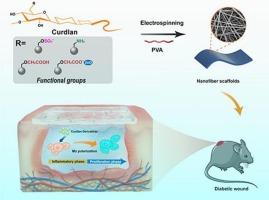Tailor-made curdlan based nanofibrous dressings enable diabetic wound healing
IF 10.7
1区 化学
Q1 CHEMISTRY, APPLIED
引用次数: 0
Abstract
The development and application of novel polysaccharides that can improve diabetic wound healing is crucial. Dressings containing curdlan have the potential to promote healing in diabetic wounds, but the underlying mechanism remain unclear. In addition, the functional modifications that could further enhance the activity of curdlan in promoting diabetic wound healing have not been explored. Herein, we investigated the capabilities of curdlan (CU) and its four derivatives i.e., sulfated curdlan (SC), amino-curdlan (AC) carboxymethyl curdlan (CMC) and CMC/ZnO nanocomposites for diabetic wound healing. Pristine CU and its derivatives were blended with polyvinyl alcohol (PVA) to fabricate electrospun nanofiber dressings (ENDs) with uniform appearances. The PVA/CU, PVA/CMC and PVA/CMC-ZnO ENDs were more compatible with keratinocytes, fibroblasts, and macrophages than that of PVA/AC ENDs. Notably, PVA/CMC ENDs and PVA/CMC-ZnO ENDs exhibited superior wound healing efficiencies than other ENDs. Among various dressings, PVA/CU, PVA/SC, PVA/CMC ENDs effectively reduced M1 macrophages and facilitated M2 phenotype at early stage of diabetic wound healing. Collectively, the PVA/CMC ENDs demonstrated greater therapeutic potential against diabetic wounds compared to other modified scaffolds via regulating macrophage polarization.

量身定制的可得然纳米纤维敷料促进糖尿病伤口愈合
开发和应用可改善糖尿病伤口愈合的新型多糖至关重要。含有姜黄素的敷料具有促进糖尿病伤口愈合的潜力,但其潜在机制仍不清楚。此外,能进一步提高姜黄素促进糖尿病伤口愈合活性的功能性修饰也尚未探明。在此,我们研究了可得然(CU)及其四种衍生物,即硫酸化可得然(SC)、氨基可得然(AC)、羧甲基可得然(CMC)和 CMC/ZnO 纳米复合材料促进糖尿病伤口愈合的能力。原始 CU 及其衍生物与聚乙烯醇(PVA)混合,制成外观均匀的电纺纳米纤维敷料(END)。与 PVA/AC END 相比,PVA/CU、PVA/CMC 和 PVA/CMC-ZnO END 与角质细胞、成纤维细胞和巨噬细胞的相容性更好。值得注意的是,PVA/CMC END 和 PVA/CMC-ZnO END 的伤口愈合效率优于其他 END。在各种敷料中,PVA/CU、PVA/SC、PVA/CMC ENDs 能在糖尿病伤口愈合早期有效减少 M1 巨噬细胞,促进 M2 表型的形成。总之,与其他改良支架相比,PVA/CMC END 通过调节巨噬细胞极化对糖尿病伤口具有更大的治疗潜力。
本文章由计算机程序翻译,如有差异,请以英文原文为准。
求助全文
约1分钟内获得全文
求助全文
来源期刊

Carbohydrate Polymers
化学-高分子科学
CiteScore
22.40
自引率
8.00%
发文量
1286
审稿时长
47 days
期刊介绍:
Carbohydrate Polymers stands as a prominent journal in the glycoscience field, dedicated to exploring and harnessing the potential of polysaccharides with applications spanning bioenergy, bioplastics, biomaterials, biorefining, chemistry, drug delivery, food, health, nanotechnology, packaging, paper, pharmaceuticals, medicine, oil recovery, textiles, tissue engineering, wood, and various aspects of glycoscience.
The journal emphasizes the central role of well-characterized carbohydrate polymers, highlighting their significance as the primary focus rather than a peripheral topic. Each paper must prominently feature at least one named carbohydrate polymer, evident in both citation and title, with a commitment to innovative research that advances scientific knowledge.
 求助内容:
求助内容: 应助结果提醒方式:
应助结果提醒方式:


